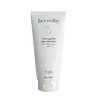What's inside
What's inside
 Key Ingredients
Key Ingredients

No key ingredients
 Benefits
Benefits

 Concerns
Concerns

 Ingredients Side-by-side
Ingredients Side-by-side

Water
Skin ConditioningSodium Stearoyl Glutamate
CleansingGlyceryl Stearate
EmollientStearic Acid
CleansingCocamidopropyl Betaine
CleansingGlycerin
HumectantPolyacrylate Crosspolymer-6
Emulsion StabilisingCetyl Alcohol
EmollientCaprylic/Capric Triglyceride
MaskingPanthenol
Skin ConditioningInulin
Skin ConditioningHydrolyzed Jojoba Esters
Skin ConditioningSaccharide Isomerate
HumectantAllantoin
Skin ConditioningBisabolol
MaskingAlpha-Glucan Oligosaccharide
CleansingAloe Barbadensis Leaf Juice Powder
Skin ConditioningCentella Asiatica Leaf Extract
Skin ConditioningXanthan Gum
EmulsifyingPhenoxyethanol
PreservativeEthylhexylglycerin
Skin ConditioningSodium Hydroxide
BufferingPotassium Sorbate
PreservativeSodium Gluconate
Skin ConditioningCitric Acid
BufferingSodium Citrate
BufferingWater, Sodium Stearoyl Glutamate, Glyceryl Stearate, Stearic Acid, Cocamidopropyl Betaine, Glycerin, Polyacrylate Crosspolymer-6, Cetyl Alcohol, Caprylic/Capric Triglyceride, Panthenol, Inulin, Hydrolyzed Jojoba Esters, Saccharide Isomerate, Allantoin, Bisabolol, Alpha-Glucan Oligosaccharide, Aloe Barbadensis Leaf Juice Powder, Centella Asiatica Leaf Extract, Xanthan Gum, Phenoxyethanol, Ethylhexylglycerin, Sodium Hydroxide, Potassium Sorbate, Sodium Gluconate, Citric Acid, Sodium Citrate
Water
Skin ConditioningSodium Methyl Cocoyl Taurate
CleansingLauramidopropyl Betaine
CleansingCocamidopropyl Hydroxysultaine
CleansingSodium Lauroyl Methyl Isethionate
CleansingSodium Chloride
MaskingGlycerin
HumectantAloe Barbadensis Leaf Juice
Skin ConditioningChamomilla Recutita Flower Extract
MaskingCucumis Sativus Fruit Extract
EmollientPolyglyceryl-3 Caprate
EmulsifyingCitric Acid
BufferingSodium Benzoate
MaskingPotassium Sorbate
PreservativePhytic Acid
Water, Sodium Methyl Cocoyl Taurate, Lauramidopropyl Betaine, Cocamidopropyl Hydroxysultaine, Sodium Lauroyl Methyl Isethionate, Sodium Chloride, Glycerin, Aloe Barbadensis Leaf Juice, Chamomilla Recutita Flower Extract, Cucumis Sativus Fruit Extract, Polyglyceryl-3 Caprate, Citric Acid, Sodium Benzoate, Potassium Sorbate, Phytic Acid
 Reviews
Reviews

Ingredients Explained
These ingredients are found in both products.
Ingredients higher up in an ingredient list are typically present in a larger amount.
Citric Acid is an alpha hydroxy acid (AHA) naturally found in citrus fruits like oranges, lemons, and limes.
Like other AHAs, citric acid can exfoliate skin by breaking down the bonds that hold dead skin cells together. This helps reveal smoother and brighter skin underneath.
However, this exfoliating effect only happens at high concentrations (20%) which can be hard to find in cosmetic products.
Due to this, citric acid is usually included in small amounts as a pH adjuster. This helps keep products slightly more acidic and compatible with skin's natural pH.
In skincare formulas, citric acid can:
While it can provide some skin benefits, research shows lactic acid and glycolic acid are generally more effective and less irritating exfoliants.
Most citric acid used in skincare today is made by fermenting sugars (usually from molasses). This synthetic version is identical to the natural citrus form but easier to stabilize and use in formulations.
Read more about some other popular AHA's here:
Learn more about Citric AcidGlycerin is already naturally found in your skin. It helps moisturize and protect your skin.
A study from 2016 found glycerin to be more effective as a humectant than AHAs and hyaluronic acid.
As a humectant, it helps the skin stay hydrated by pulling moisture to your skin. The low molecular weight of glycerin allows it to pull moisture into the deeper layers of your skin.
Hydrated skin improves your skin barrier; Your skin barrier helps protect against irritants and bacteria.
Glycerin has also been found to have antimicrobial and antiviral properties. Due to these properties, glycerin is often used in wound and burn treatments.
In cosmetics, glycerin is usually derived from plants such as soybean or palm. However, it can also be sourced from animals, such as tallow or animal fat.
This ingredient is organic, colorless, odorless, and non-toxic.
Glycerin is the name for this ingredient in American English. British English uses Glycerol/Glycerine.
Learn more about GlycerinPotassium Sorbate is a preservative used to prevent yeast and mold in products. It is commonly found in both cosmetic and food products.
This ingredient comes from potassium salt derived from sorbic acid. Sorbic acid is a natural antibiotic and effective against fungus.
Both potassium sorbate and sorbic acid can be found in baked goods, cheeses, dried meats, dried fruit, ice cream, pickles, wine, yogurt, and more.
You'll often find this ingredient used with other preservatives.
Learn more about Potassium SorbateWater. It's the most common cosmetic ingredient of all. You'll usually see it at the top of ingredient lists, meaning that it makes up the largest part of the product.
So why is it so popular? Water most often acts as a solvent - this means that it helps dissolve other ingredients into the formulation.
You'll also recognize water as that liquid we all need to stay alive. If you see this, drink a glass of water. Stay hydrated!
Learn more about Water